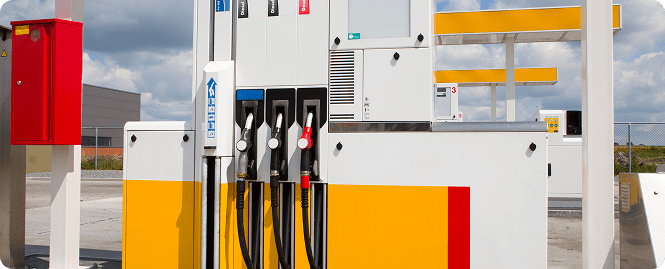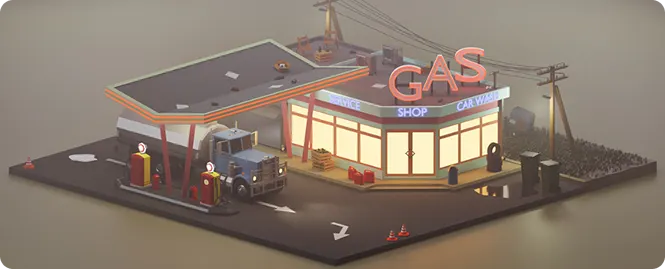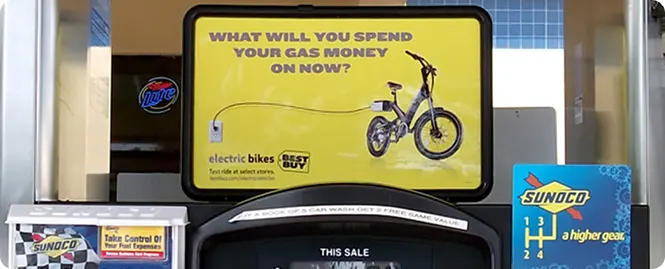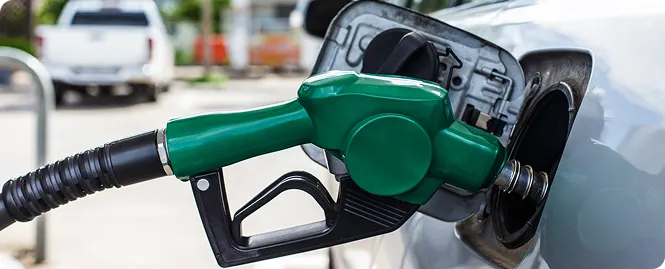How to Open a Gas Station in Texas
Table of Contents
Key Takeaways
-
Conduct thorough market analysis to identify high-traffic areas with strong demand. Consider local competition, accessibility, and zoning laws to ensure your gas station’s long-term success.
-
Outline your startup costs, projected revenue, marketing strategies, and operational plans. A solid business plan will help secure financing and provide a roadmap for growth.
-
Obtain necessary permits and licenses, comply with environmental regulations, and choose the right business structure. Explore financing options like SBA loans, private investors, or gas station franchises.
-
Select reliable fuel dispensers, storage tanks, and POS systems. Partner with trustworthy fuel suppliers and hire well-trained employees to ensure efficient daily operations and excellent customer service.
-
Implement strong marketing strategies, including local promotions and loyalty programs. Regular maintenance, competitive fuel pricing, and excellent customer service will keep your gas station profitable in the long run.
Texas has a thriving gas station industry driven by high vehicle usage and a growing economy. Gas station owners can achieve strong profit margins with the right location and business model. While startup costs can be significant, adding convenience stores and additional services can enhance revenue. However, competition is fierce, and fluctuating fuel prices impact profitability. Successful gas station businesses focus on strategic market analysis, competitive pricing, and customer loyalty programs to maximize long-term earnings.
Opening a gas station in Texas can require a lot of careful planning and compliance with various regulations. From selecting a business structure to securing financing, obtaining permits, and choosing suppliers, every step significantly impacts the success of your venture. A comprehensive business plan, thorough market research, and awareness of operational challenges are crucial. Understanding these factors will help business owners navigate the complexities of owning a gas station and building a profitable, sustainable business.
Step 1: Researching the Market and Location
Selecting an ideal location is crucial for a profitable gas station in Texas. High-traffic areas near highways, intersections, or growing communities ensure a steady customer flow. Consider factors such as accessibility, ease of entry and exit, and proximity to competitors. Zoning laws and property costs also impact long-term success. A well-placed gas station attracts regular customers and maximizes revenue. Thorough research and planning can help secure a prime spot that offers both convenience and profitability.
Understanding the locals’ demand and traffic flow is essential for success. Conduct a market analysis to determine peak travel times and high-traffic areas. Assessing competitors existing in the area helps identify pricing strategies and additional services to offer, such as convenience stores or car wash services. Choosing a location that has limited competition but strong demand can give your gas station a competitive edge, ensuring consistent business and long-term sustainability in the Texas market.
Texan consumers have specific fueling and purchasing habits. Some prioritize competitive gas prices, while others seek premium fuel, clean restrooms, or quick snacks. Convenience stores with fresh coffee and grab-and-go meals appeal to commuters. Aligning your services with local consumer needs increases customer loyalty, sales, and strengthens your station’s profitability.
Step 2: Creating a Business Plan
A well-structured business plan is an essential step toward successfully opening a gas station in Texas. It serves as a roadmap, guiding you through startup, operations, and growth. Your plan should outline your business structure, target market, and revenue streams. A solid plan not only keeps you on track but increases your chances of securing financing from lenders or investors. Taking the time to develop a detailed strategy will help ensure long-term profitability and sustainability.
Your gas station business plan should include certain details such as financial projections, startup costs, and an estimated timeline for profitability. Marketing strategies, including promotions, loyalty programs, and digital advertising, can play a critical role in attracting loyal customers. Operational details such as fuel supplier contracts and convenience store management should also be addressed. Setting clear revenue goals and outlining competitive pricing strategies will help maintain a steady cash flow and maximize your station’s earning potential.
Beyond the initial setup, your business plan should also include strategies that support long-term growth. Consider expansion opportunities such as adding additional fuel pumps, opening new locations, or offering additional services, such as tire repairs or electric vehicle charging stations. Adapting to industry trends and consumer demands will help you stay relevant and competitive in the market. A well-thought-out plan helps ensure that your gas station remains successful and profitable for years to come.
Step 3: Legal and Regulatory Requirements
Opening a gas station in Texas requires obtaining the necessary permits, licenses, and business registrations. You’ll need a business license, tax identification number, and fuel retailer permit. Environmental permits and underground storage tank (UST) registrations are also essential for compliance. Working with state agencies such as the Texas Commission on Environmental Quality (TCEQ) and the Texas Department of Licensing and Regulation (TDLR) will help streamline the approval process easily and ensure your business operates legally.
Before construction begins, it is crucial to understand local zoning laws and land-use regulations. Zoning laws determine where gas stations can and cannot be built, considering factors such as proximity to schools, residential areas, and environmental impact. Permits for underground fuel storage tanks, fire safety measures, and accessibility compliance must also be secured. Consulting with local government offices and zoning authorities will help you avoid costly mistakes and ensure your business meets all legal requirements.
Gas stations must comply with strict environmental regulations to prevent contamination and hazardous spills. Fuel storage regulations require regular inspections, leak detection systems, and proper waste disposal measures. The TCEQ enforces guidelines on air quality, groundwater protection, and fuel handling. Staying compliant protects your business from fines and ensures safety for customers and the surrounding community. Investing in high-quality storage tanks and leak prevention systems can save you from costly liabilities in the long run.
Step 4: Securing Financing
Starting a gas station in Texas requires significant capital, and securing financing is crucial. Entrepreneurs can explore bank loans, Small Business Administration (SBA) loans, private investors, or gas station franchise financing. Traditional bank loans often require strong credit and collateral, while SBA loans offer lower interest rates and longer repayment terms. Additionally, partnering with investors provides financial support in exchange for equity. Choosing the right financing option depends on your business structure and long-term goals.
To secure funding, you need a well-prepared business plan and financial documents. Lenders and investors will thoroughly review your financial projections, startup costs, and expected profit margins. Essential documents should include a cash flow statement, income statement, balance sheet, and market analysis. With a compelling pitch, you can highlight your strategy for profitability, competitive advantage, and risk management. Having a comprehensive business plan will help in increasing your chances of securing financing with favorable terms.
Texas offers a wide range of government programs and grants to support small business owners in the gas station industry. The SBA provides loan assistance, while state initiatives offer financial aid for fuel-efficient stations or businesses in underserved areas. The Texas Economic Development Corporation and local municipalities may provide grants, tax incentives, or funding for more environmentally friendly fuel options. Exploring these resources can reduce startup costs and improve financial sustainability in the long run.
Step 5: Selecting the Right Equipment and Suppliers
Running a gas station in Texas requires the right equipment to ensure smooth operations. Fuel dispensers, underground or above-ground storage tanks, and point-of-sale (POS) systems are the backbone of any station. Security cameras, fire suppression systems, and spill containment equipment are also essential for safety and compliance. Investing in modern payment processing systems, including contactless and mobile payment options, further enhances customer convenience. Proper maintenance of equipment is crucial to avoid downtime and costly repairs.
Choosing a trustworthy fuel supplier is vital for maintaining a steady fuel supply and ensuring competitive pricing. When selecting a supplier, consider factors such as fuel quality, delivery reliability, and pricing structures. Negotiating favorable contract terms can be useful in securing bulk purchase discounts and flexible payment options. Some suppliers even offer branding opportunities that help independent gas station owners compete with major franchises. Understanding constant fuel price fluctuations and demand trends can improve profitability.
Beyond fuel sales, adding a convenience store, car wash, or auto repair service can significantly drive an increase in profits. Convenience stores generate revenue by offering snacks, beverages, and essential items for travelers. Car washes and repair services help attract repeat customers and create additional income streams. Partnering with local vendors for unique products can help make your station stand out. A well-planned layout, competitive pricing, and excellent customer service contribute to long-term success.
Step 6: Building and Designing the Gas Station
Building a gas station in Texas requires thorough planning to maximize the overall efficiency and convenience of customers. The layout should include spacious fueling areas, a well-positioned convenience store, and clear entry and exit points to ensure smooth traffic flow. Incorporating energy-efficient lighting, durable canopy structures, and modern architecture enhances both aesthetics and functionality. Adequate parking and easy access to amenities like air pumps and vacuum stations further improve customer satisfaction and increase foot traffic.
Safety and regulatory compliance should be your top priorities when constructing a gas station. Texas has strict building codes that require proper fuel storage systems, fire suppression measures, and spill containment solutions. One can ensure accessibility by incorporating ADA-compliant ramps, signage, and pathways. Also, maintaining well-lit areas and installing security cameras can further enhance customer and employee safety. Adhering to local zoning laws and environmental guidelines prevents legal issues and ensures smooth operations.
A well-designed gas station layout improves customer experience and boosts sales. An organized store layout with clear signage and strategically placed product displays encourages impulse purchases. Wide fueling lanes and easy-to-navigate parking areas can reduce congestion. Features like clean restrooms, comfortable seating, and quick-service food options can enhance customer loyalty.
Step 7: Hiring and Training Employees
Finding the right employees is vital in order to run a successful gas station. Look for individuals with strong customer service skills, reliability, and a willingness to learn. Hiring for key roles, including cashiers, maintenance staff, and store managers, ensures smooth operations. Conduct thorough interviews, background checks, and reference verifications to build a trustworthy team. Offering competitive wages, flexible schedules, and employee benefits can attract and retain high-quality staff, reducing turnover and improving overall service.
Thorough training is vital for empowering employees so they carry out their daily tasks with confidence and safety. Staff should be trained in fuel handling procedures, emergency response, and theft prevention. Customer service training helps employees engage positively with patrons, improving satisfaction and repeat business. Operational training on POS systems, restocking procedures, and store maintenance ensures smooth workflow. Ongoing training programs keep employees updated on industry best practices, enhancing overall service quality and workplace safety.
A well-structured scheduling and payroll system helps manage your workforce. Use scheduling software to assign shifts, prevent understaffing, and accommodate peak hours. An automated payroll system ensures accurate and timely wage distribution, tax deductions, and compliance with labor laws. Efficient scheduling and payroll management improve employee morale and streamline operations.
Step 8: Marketing and Promotion
Launching a gas station requires a strong local advertising strategy in order to attract more customers. Utilize eye-catching signage, distribute flyers, and run ads in local newspapers and radio stations. Host a grand opening event with discounts and giveaways to generate buzz. Offering limited-time fuel discounts or free car washes can entice new customers. Engaging in community sponsorships, such as supporting local sports teams or charities, also helps establish brand recognition and customer loyalty.
In today’s digital world, social media is a powerful tool for marketing your gas station. Create business pages on platforms like Facebook, Instagram, and Google My Business to share promotions, fuel price updates, and special offers. Introduce a loyalty program with discounts or rewards for repeat customers. Partner with food delivery services or offer bundled deals on snacks and fuel to increase sales. Running seasonal promotions and referral incentives can further attract and retain customers.
Collaborate with nearby convenience stores, repair shops, or fast-food chains for cross-promotions. Sponsoring local events, like school fundraisers or farmers’ markets, builds community trust and attracts loyal customers. Engaging with neighborhood associations and offering exclusive discounts to local businesses solidifies your station’s reputation as a valuable part of the community.
Step 9: Ongoing Operations and Maintenance
Efficient day-to-day operations are crucial steps towards running a successful gas station. Inventory management ensures fuel availability and stocked convenience store shelves. Implementing a reliable point-of-sale (POS) system helps track sales and manage supplies effectively. Fuel pricing strategies should consider factors like market fluctuations, competitor rates, and profit margins. Dynamic pricing models and loyalty programs can help attract repeat customers. Regular monitoring of fuel levels, supplier contracts, and financial reports is essential for maintaining profitability.
A well-maintained gas station improves the safety and experience of customers. Regular inspections of fuel dispensers, storage tanks, and fire suppression systems help prevent hazards. Compliance with local, state, and federal safety regulations, including environmental and fuel storage guidelines, is mandatory. Installing proper lighting, security cameras, and anti-theft measures ensures customer and employee safety. Routine maintenance of pumps, restrooms, and store areas contributes to a clean and professional environment, encouraging customer satisfaction and repeat visits.
Encourage customers to leave reviews through online surveys. Address complaints promptly and implement changes based on feedback. Regular staff training on customer service and conflict resolution, and introducing new services like air pumps, vacuum stations, or a wider variety of convenience store products helps meet customer needs and increase satisfaction.
Conclusion
Opening a gas station in Texas involves research, securing financing, obtaining permits, and selecting equipment. Hiring the right team, marketing effectively, and maintaining daily operations are highly crucial in ensuring long-term success. With careful planning and smart decision-making, your gas station can thrive and become a trusted stop for customers.
Proper insurance coverage can help protect your gas station from financial losses due to accidents, theft, or property damage. Coverage like general liability, property insurance, and workers' compensation ensures business continuity. Without proper insurance, unexpected events can lead to costly setbacks. A strong policy keeps your business secure and running smoothly.










